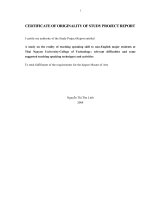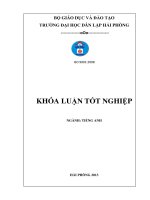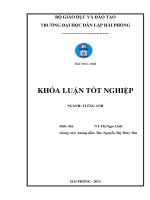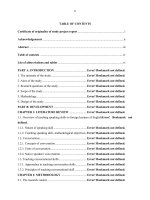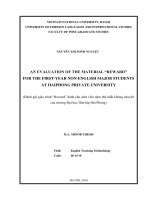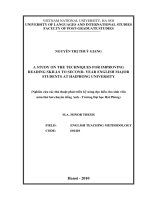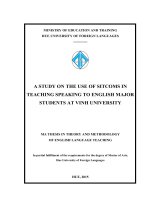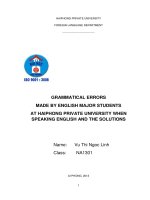A study on the vocabulary learning strategies employed by 2nd year english majors students at hai phong private university
Bạn đang xem bản rút gọn của tài liệu. Xem và tải ngay bản đầy đủ của tài liệu tại đây (610.19 KB, 57 trang )
BỘ GIÁO DỤC VÀ ĐÀO TẠO
TRƯỜNG ĐẠI HỌC DÂN LẬP HẢI PHÒNG
-------------------------------
ISO 9001:2015
KHÓA LUẬN TỐT NGHIỆP
NGÀNH: NGÔN NGỮ ANH
Sinh viên
Giảng viên hướng dẫn
: Nguyễn Thị Lan Hương
: ThS. Phan Thị Mai Hương
HẢI PHÒNG - 2018
i
MINISTRY OF EDUCATION AND TRAINING HAIPHONG PRIVATE
UNIVERSITY -----------------------------------
A STUDY ON THE VOCABULARY LEARNING STRATEGIES
ND
EMPLOYED BY 2 -YEAR ENGLISH MAJORS STUDENTS
AT HAI PHONG PRIVATE UNIVERSITY.
GRADUATION PAPER
Student
Class
Supervisor
: Nguyen Thi Lan Huong
: NA1802
: Phan Thi Mai Huong (M.A)
HẢI PHÒNG - 2018
ii
BỘ GIÁO DỤC VÀ ĐÀO TẠO
TRƯỜNG ĐẠI HỌC DÂN LẬP HẢI PHÒNG
--------------------------------------
NHIỆM VỤ ĐỀ TÀI TỐT NGHIỆP
Sinh viên: Nguyễn Thị Lan Hương
Mã SV:1412751047
Lớp: NA1802
Ngành:Ngôn Ngữ Anh
Tên đề tài: “A study on the vocabulary learning strategies employed by
2nd-year English majors students at Hai Phong Private University.”
iii
NHIỆM VỤ ĐỀ TÀI
1. Nội dung và các yêu cầu cần giải quyết trong nhiệm vụ đề tài tốt nghiệp (
về lý luận, thực tiễn, các số liệu cần tính toán và các bản vẽ).
……………………………………………………………………………..
……………………………………………………………………………..
……………………………………………………………………………..
……………………………………………………………………………..
……………………………………………………………………………..
……………………………………………………………………………..
……………………………………………………………………………..
……………………………………………………………………………..
2. Các số liệu cần thiết để thiết kế, tính toán.
……………………………………………………………………………..
……………………………………………………………………………..
……………………………………………………………………………..
……………………………………………………………………………..
……………………………………………………………………………..
……………………………………………………………………………..
……………………………………………………………………………..
……………………………………………………………………………..
……………………………………………………………………………..
3. Địa điểm thực tập tốt nghiệp.
……………………………………………………………………………..
……………………………………………………………………………..
……………………………………………………………………………..
iv
CÁN BỘ HƯỚNG DẪN ĐỀ TÀI TỐT NGHIỆP
Người hướng dẫn thứ nhất:
Họ và tên:............................................................................................. .
Học hàm, học vị:............................................ .......................................
Cơ quan công tác:.................................................................................
Nội dung hướng dẫn:............................................................................
Người hướng dẫn thứ hai:
Họ và tên:.............................................................................................
Học hàm, học vị:...................................................................................
Cơ quan công tác:.................................................................................
Nội dung hướng dẫn:............................................................................
Đề tài tốt nghiệp được giao ngày tháng
năm
Yêu cầu phải hoàn thành xong trước ngày
tháng
Đã nhận nhiệm vụ ĐTTN
Đã giao nhiệm vụ ĐTTN
Sinh viên
năm
Người hướng dẫn
Hải Phòng, ngày ...... tháng........ năm 2018
Hiệu trưởng
GS.TS.NGƯT Trần Hữu Nghị
v
TABLE OF CONTENT
ACKNOWLEDGMENT ..................................................................................... 1
ABSTRACT ........................................................................................................ 2
CHAPTER ONE: INTRODUCTION.................................................................. 3
1. Rationale ......................................................................................................... 3
2. Objectives of the study .................................................................................... 4
3. Research Questions ......................................................................................... 4
4. Scope of the study ........................................................................................... 4
5. Method of the study ......................................................................................... 5
6. Design of the study .......................................................................................... 5
CHAPTER TWO - LITERATURE REVIEW ..................................................... 6
2.1 Introduction ................................................................................................... 6
2.2. Language learning strategies. ....................................................................... 6
2.2.1 The definitions of learning strategies.......................................................... 6
2.2.2 The characteristics of learning strategies .................................................... 7
2.2.3 Classifications of learning strategies .......................................................... 8
2.3 Vocabulary and vocabulary learning strategies ........................................... 14
2.3.1 Construct of knowing a word ................................................................... 14
2.3.2 Vocabulary learning strategies ................................................................. 16
CHAPTER 3 - THE STUDY ............................................................................ 26
3.1 Research questions ...................................................................................... 26
3.2 Participants .................................................................................................. 26
3.4 Data collection procedure ............................................................................ 29
3.5 Data analysis procedure ............................................................................... 29
3.5.1 Applying Determination strategies to learning English vocabulary ............... 29
3.5.2 Applying Social strategies to learning English vocabulary ...................... 31
3.5.3 Applying Memory strategies to learning vocabulary ................................ 32
3.5.4 Applying Cognitive strategies to learning vocabulary .............................. 34
3.5.5 Applying Metacognitive strategies to learning vocabulary....................... 35
3.6 Overall vocabulary learning strategy use ..................................................... 36
3.7 The differences in the use of vocabulary learning strategies in terms of
gender ................................................................................................................ 36
3.8 Summary ..................................................................................................... 38
CHAPTER 4: ANALYSIS AND DISCUSSION .............................................. 39
vi
4.1 Vocabulary Learning Strategies used by the student of 2nd-year English
majors at HPU: What and How often?................................................................39
4.2 The differences in the use of vocabulary learning strategies in terms of
gender.................................................................................................................. 41
CHAPTER 5: CONCLUSION............................................................................42
5.1 Summary and Implications............................................................................42
5.2 Limitations and suggestions for further study...............................................43
REFERENCES....................................................................................................................................... 44
APPENDIX.............................................................................................................................................. 46
vii
LIST OF TABLES
Table 1: Components of learning strategies..........................................................7
Table 2: Features of language learning strategies................................................. 8
Table 3: Direct learning strategies.......................................................................12
Table 4: Indirect learning strategies.................................................................... 14
Table 6: Taxonomy of vocabulary learning strategies.........................................22
Table 7: Vocabulary Learning Strategies in The Questionnaire..........................27
Table 8: The questionnaire............................................................................................................... 28
Table 9: Comparisons of Strategy Use by Gender.............................................. 38
viii
LIST OF FIGURES
Figure 1: Students’ use of DET strategies in vocabulary learning...................... 30
Figure 2: Students’ use of SOC strategies in vocabulary learning......................31
Figure 3: Students’ use of MEM strategies in vocabulary learning....................33
Figure 4: Students’ use of COG strategies in vocabulary learning..................... 34
Figure 5: Students’ use of MET strategies in vocabulary learning.....................35
Figure 6: Statistics of five groups of vocabulary learning strategies..................39
ix
ACKNOWLEDGMENT
During the process of doing this graduation paper, I have received many
necessary assistances, precious ideas and timely encouragements from my
teachers, family and friends. This paper could not have been completed without
the help, encouragement and support from a number of people who all deserve
my sincerest gratitude and appreciation.
First of all, I would like to express my gratitude and appreciation to the
teachers of The Foreign Languages Department of HaiPhong Private University,
who have imparted golden knowledge to me. From these support, I was able to
improve my English skills and have a solid background to make my dream come
true.
Secondly, I wish to express my deepest gratitude to my supervisor – Mrs.
Phan Thi Mai Huong, the English teacher of English Department, who has
always been willing to give me valuable advices and suggestions in order that I
can complete successfully this study.
I am so thankful to students of K21 at the Foreign Language Department
for their whole – heart participation in the study.
I would like to acknowledge my thanks to all the authors of the books,
magazines, and the other materials listed in the reference part for their ideas that
have been reflected and developed in the study.
I am equally indebted to my classmates for their suggestions and
encouragements in the process of my study.
Last but not least, my particular thanks are given to my parents for their
encouragement and support which played an important role in my graduation
paper.
1
ABSTRACT
One of the most important challenges that learners will face during the
process of second language learning is vocabulary learning. Vocabulary has been
recognized as crucial to language use in which insufficient vocabulary
knowledge of the learners led to difficulties in second language learning. Thus,
in the case of learning the vocabulary in second language, students need to be
educated with vocabulary learning strategies. The purpose of this study was to
examine and develop effective vocabulary learning strategies of HPU (HaiPhong
Private University) second-year English majors. The sample of the study
consists of twenty-five students (fifty-five female students and ten male students
from K21), all of them are junior students at English Department (ED) at HPU.
Hence, the method of conducting is an open-ended interview that was conducted
individually with twenty-five students in HPU. The strategies such as the
learning a word through reading, the use of monolingual dictionary, the use of
various English language media, and applying new English word in their daily
conversation where are related to memory, determination, metacognitive
strategies respectively are popular strategies and the learners are keen in using
them.
2
CHAPTER ONE: INTRODUCTION
1. Rationale
“Without grammar very little can be conveyed, without vocabulary
nothing can be conveyed.” (Cited in Hoang Tat Truong 1985:1). The saying
sounds very familiar with many people. However, the researcher still wants to
repeat it once more to confirm the importance of vocabulary in any language. “If
a language could be considered as a house, then its grammar could be considered
as cement and its vocabulary could be figuratively compared to bricks. To build
a complete house, no only cement but also bricks are needed. Without bricks, no
house can be built, even when plenty of high quality cement is available.”
(Nguyen Huyen, 2004:1). This means that to be a competent English
communicator, one must acquire a good knowledge of English grammar and
have a rich amount of English vocabulary as well. Vocabulary is an essential
element of language. Whether in speaking or writing, learners need vocabulary
to communicate and understand others. In many cases, learners produce
grammatically incorrect sentences, but they still get their message across if they
use key words appropriately. In other cases, learners may feel uncomfortable
because they fail to employ certain words, or do not know the words to express
themselves. Vocabulary is not only indispensable for personal communication,
but also for academic study. In fact, many standardized tests require knowledge
of vocabulary such as TOFFLE, IELTs, GMAT, etc. For this reason, learners
must give high priority to learning and developing their knowledge of
vocabulary.
For a long time in the past, methodologists have continuously kept
seeking effective ways to teach English vocabulary but learning English.
Teacher’s role and teaching tools have been paid so much attention. Fortunately,
it has been witnessed that there has been a prominent shift in the field of
language teaching and learning over the last few decades with greater emphasis
being put on learners and learning rather than on teachers and teaching. This
change has been reflected in various ways in language education and in applied
linguistics. Many books on learning strategies have been introduced by such
experts as Oxford (1990), O’Malley and Charmot (1990), Nunan (1991), Nation
(1990) and so on. Some books on vocabulary learning strategies have been
3
written by such scholars as Nation (1982, 1990, and 2001), Rubin and
Thompson (1994) and Taylor (1990), etc.
In Vietnam, there has so far been some research on vocabulary learning
strategies. However, research on vocabulary learning strategies employed by
students at HPU.
As a student of English Major, I have dealt with many questions relating
to vocabulary learning which are raised by students. For example, what are the
effective ways of learning vocabulary? How to retain a new word in the mind?
Personally I found it necessary to provide to them successful learning strategies
to learn English words. This is the major reason why this topic interests me.
2. Objectives of the study
The objective of the study is to explore what strategies are commonly
used by students in learning vocabulary and the relationship between the use of
vocabulary learning strategies and the gender.
In order to establish a theoretical framework for the investigation in this
thesis, the literature on language learning strategies, vocabulary learning and
related issues is reviewed.
3. Research Questions
The study set out to seek answers to the following research questions:
1. What vocabulary learning strategies are commonly used by the students
of 2nd-year English majors at Hai Phong Private University (HPU)?
2.Do students’ gender have any impacts on their use of vocabulary learning
strategies?
4. Scope of the study
The study was designed to investigate vocabulary learning strategies which
are employed by the students of the students of 2 nd-year English majors at Hai
Phong Private University (HPU)? It also finds out the differences in the use of
vocabulary learning (VL) strategies among groups of students in relation to
gender. The findings obtained from this study were to help improve teaching and
learning English in general and teaching and learning English vocabulary in
particular at HPU.
4
5. Method of the study
In order to achieve the aims of the study mentioned above, the
quantitative analysis is the main tool for analyzing the data, which is collected
from the questionnaire.
After the data is analyzed and discussed, the findings will be showed and
some conclusions will be drawn and some suggestions will be raised in the
thesis.
6. Design of the study
The thesis is divided into five chapters:
Chapter 1 includes the rationale, the subjective, the research questions, the
scope, the method and the design of the study.
Chapter 2 covers the information about vocabulary learning strategy
research, some basis concepts related to learning strategies and vocabulary
learning. In addition, learning strategies and learning strategy classification are
reviewed to set up the theoretical framework for the investigation in the next
chapter.
In chapter 3, the study is presented. It includes the context of the study, the
research questions, the research method, the study participants and the findings
of the study.
Chapter 4 discusses the use of vocabulary learning strategies by the
students of 2nd-year English majors at Hai Phong Private University (HPU) and
the differences among groups of students by gender.
In the last chapter, chapter 5 contains some conclusions and some
limitations of the study as well as suggestions for further research.
5
CHAPTER TWO - LITERATURE REVIEW
2.1 Introduction
In this chapter, a brief review of learning strategy research is given; some
basic concepts related to learning strategies and vocabulary learning are also
presented. In addition, the classification of learning strategies in general and
vocabulary learning strategies in particular are reviewed to set up the theoretical
framework for the investigation in the next chapter.
2.2. Language learning strategies.
2.2.1 The definitions of learning strategies
It is clearly seen that research on learning strategies in general and language
learning strategies in particular is becoming increasingly popular. So far, there
has been no consensus among the linguists regarding to the definitions of
leaning strategies.
According to Nunan (1991:168), “Learning strategies […] are the mental
processes which learners employ to learn and use the target language”. Nunan’s
definition restricts learning strategies only to “mental processes”. Richard et al.
(1992:209), offers a broader definition of learning strategies, that is, learning
strategies are intentional behavior and thoughts that learners make use of during
learning in order to better help them understand, learn and remember new
information.” Similarly, Weinstein and Mayer (1986) (in O’ Malley and Charmot
1990:43) have learning facilitation as a goal and are intentional on the part of the
learner. The goal of strategy use is to affect the leaner’s motivational or affective
state, or the way in which the learner selects, acquires, organizes, or integrates
new knowledge.”
Oxford (1990:8) defines learning strategies as “specific actions taken by the
learner to make learning easier, faster, more enjoyable, more self directed, more
effective and more transferable to new situation.”
Ellis defines learning strategies as “the particular approaches or techniques
that learner employs to try to learn an L2.” (1997:76). He furthers explains that
learning strategies can be behavioral or mental and are typically problem oriented.
Rubin (in Wenden and Rubin 1987:19) is even more explicit when he
defines learning strategies as “any set of operations, steps, plans, routines used
6
by the learner to facilitate the obtaining, storage, retrieval and use of
information, that is, what learner do to learn and do to regulate their learning.”
According to O’Malley and Charmot (1990:1), learning strategies are
special ways of processing information that enhance comprehension, learning, or
retention of the information” or in their other words learning strategies are the
“special thoughts or behaviors that individuals use to help them comprehend,
learn, or retain new information.”
Obviously, learning strategies are defined in different words and from
different perspectives such as cognitive, social or pragmatic. Therefore,
researchers worked out the taxonomy of learning strategies instead of defining
them. This can be seen in the following part.
2.2.2 The characteristics of learning strategies
Learning strategies are techniques, approaches or deliberate actions that
students take in order to facilitate the learning and recall of both linguistic and
content information and to make learning easier, faster, more enjoyable, more
self directed, more effective, and more transferable to new situations.
Wenden and Rubin (1987: 7-8) claimed that learning strategies were
composed of the following components:
Components of learning strategies
1. They are specific actions or techniques.
2. They can be observable or non-observable / mental.
3. They are problem-oriented.
4. They can contribute directly or indirectly to learning.
5. They may be consciously employed and became automatized.
6. They are changeable.
Table 1: Components of learning strategies
Source: Wenden and Rubin (1987: 7-8)
Oxford (1990:9) offers a more comprehensive list of the features of
language learning strategies as the following:
Features of language learning strategies
1. Contribute to the main goal, communicative competence.
2. Allow learners to be more self-directed.
3. Expand the role of the teacher.
4. Are problem-oriented.
7
5. Are specific actions taken by the learner
6. Involve many aspects of the learner, not just the cognitive.
7. Support learning both directly and indirectly.
8. Are not always observable.
9. Are often conscious.
10. Can be taught.
11. Are flexible
12. Are influenced by a variety of factors
Table 2: Features of language learning strategies.
Source: Oxford (1990:9)
2.2.3 Classifications of learning strategies
In the literature, like the definition of learning strategies, learning strategies
are classified differently by different scholars.
Wenden (1991:18) divides learning strategies into two broad groups as
follows:
Cognitive strategies
Self-management strategies.
In her explanation, cognitive strategies are mental steps or operations
learners use to process both linguistic and sociolinguistic content. Selfmanagement strategies are used to oversee and manage the learner’s learning.
She notes that in cognitive psychology self-management strategies are called
metacognitive or regulatory strategies.
Rubin, who pioneered much of the work in the field of strategies, make the
distinction between strategies contributing directly to learning and those
contributing indirectly to learning. According to Rubin (1987), there are three
types of strategies used by learners that contribute directly and indirectly to
language learning. These are:
Learning strategies
Communication strategies
Social strategies
Learning strategies include two main types: cognitive learning strategies
and metacognitive learning strategies. Cognitive learning strategies refer to the
steps or operations used in learning or problem solving that require direct
analysis, transformation or synthesis of learning materials. Rubin identifies 6
8
main cognitive learning strategies contributing directly to language learning.
They
are
clarification/verification,
monitoring,
memorization,
guessing/inductive inferencing, deductive reasoning and practice. The indirect
strategies include creating opportunities for practice and productions tricks.
Naiman et al. (in O’Malley and Charmot 1990:4) offers a classification
schema of 5 broad categories of learning strategies and a number of secondary
categories. Their broad categories of learning strategies include: an active task
approach, realization of language as a system, realization of language as a means
of communication and interaction, management of affective demands, and
monitoring of L2 performance.
O’Malley and Charmot (1990) analyzed learning strategies in parallel with
language learning. Learning strategies were defined as complex cognitive skills.
O’Malley divides language learning strategies into three main subcategories:
Metacognitive strategies
Cognitive strategies
Social affective strategies.
Metacognitive strategies involve contemplating learning processes such as
planning, monitoring, analyzing, and assessing learning which are indirectly
involved in learning. Cognitive strategies are more limited to specific learning
tasks and they involve more directly manipulation of the learning materials
itself. They include strategies such as rehearsal, organization, inferencing,
summarizing, deducing, imaginary, transfer, and elaboration. Social affective
strategies are related with social mediating activity and transacting with others.
According to Stern (1992), there are five main language learning strategies.
These are as follows:
Management and planning strategies.
Cognitive strategies
Communicative -Experiential strategies
Interpersonal strategies
Affective strategies
Oxford (1990:9) see the aims of language learning strategies as being
oriented towards the development of communicative competence. Oxford
9
divides the language learning strategies into main classes, direct and indirect,
which are further divided into 6 subgroups. In Oxford’s system, metacognitive
strategies help learners regulate their learning. Affective strategies are concerned
with the learner’s emotional requirements such as confidence, while social
strategies lead to increased interaction with the target language. Cognitive
strategies are the mental strategies the learners use to make sense of their
learning, memory strategies are those used to the storage of information, and
compensation strategies help learners overcome their knowledge gaps to
continue the communication.
Oxford’s (1990:17) taxonomy of language learning strategies is shown in
the following:
Class
Set of strategies
Specific strategies
1. Grouping
a. Creating mental
linkage
2.
Associating/Elaborating
3. Placing new words into
a context
1. Using imaginary
I. Memory strategies
2. Semantic mapping
b. Applying images and
3. Using key words
sounds
4. Representing sounds in
memory.
c. Reviewing well
1. Structured reviewed
d. Employing action
1. Using physical
response or sensation
2. Using mechanical
techniques
a. Practicing
1. Repeating
10
2. Formally
practicing
with sounds and writing
systems
3. Recognizing and using
formulas and patterns
4. Recombining
5. Practicing
naturalistically
II. Cognitive strategies
b. Receiving and sending 1. Getting the idea
messages
quickly
2. Using resources for
receiving and sending
messages
1. Reasoning deductively
2. Analyzing expressions
c. Analyzing and
reasoning
3. Analyzing
contrastively (across
languages)
4. Translating
5. Transferring
d. Creating structure for
input and output
1. Taking notes
2. Summarizing
3. Highlighting
a. Guessing intelligently
1. Using linguistic clues
2. Using other clues
b. Overcoming
limitations in speaking
1. Switching to the
mother tongue
and writing
2. Getting help
11
3. Using mime or gestures
III. Compensation
4. Avoiding
communication partially
Strategies
of totally
5. Selecting the topic
6. Adjusting or
approximating the
message
7. Coining words
8. Using a circumlocution
or synonym
Table 3: Direct learning strategies
(Source: Oxford (1990:18)
Group
Set of strategies
a. Centering your
learning
Specific strategies
1. Overviewing and lining with
already known material
2. Paying attention
3. Delaying speech
b. Arranging and
planning your learning
1. Finding out about language
learning
2. Organizing
3. Setting goals and objectives
I. Metacognitive
4. Identifying the
purpose of
strategies
language
(purposeful
task
listening
reading/speaking/writing)
12
/
5. Planning your task
6. Seeking practice
opportunities
c.
Evaluating
learning
your 1. Self-monitoring
2. Self-evaluating
1. Using progressive
relaxation, deep breathing, or
a. Lowering your anxiety mediation
2. Using music
3. Using laughter
1. Making positive statements
II. Affective strategies
b. Encouraging yourself
2. Taking risks wisely
3. Rewarding yourself
1. Listening to your body
2. Using checklist
c. Taking your emotional
temperature
3.Writing a language learning
diary
4. Discussing your feelings
with someone else.
a. Asking questions
1. Asking for clarification or
verification
2. Asking for correction
b. Cooperating with
13
1. Cooperating with peers
others
2. Cooperating with proficient
III. Social strategies
users of the new language
c. Empathizing with
others
1. Developing cultural
understanding
2. Becoming aware of others’
thoughts and feelings
Table 4: Indirect learning strategies
(Source: Oxford (1990:20)
2.3 Vocabulary and vocabulary learning strategies
2.3.1 Construct of knowing a word
Many people believe that knowing a word means knowing its meaning.
Cook (2001:61) states that “a word is more than its meaning.” For Cook,
knowing a word may involve four aspects: form of the word (for instance
spelling and pronunciation), grammatical properties (for example, grammatical
category of a word, its possible and impossible structure), lexical properties (for
instance, word combinations and appropriateness), and general meaning and
specific meaning.
Stahl (1999:15) thinks that there are four levels of word knowledge: (1)
word that one never saw (2) word that one has heard of but does not know what
it means, (3) word that one recognizes in context and can explain that it has
something to do with, (4) word one knows.
Yings (2000) describes some types of context clues that may be available to
the readers to guess the meaning of unknown words. These are the morphology
(for instance, derivation), reference word (such as pronouns), cohesion (for
instance,
co-occurrence),
definitions,
antonyms,
synonyms,
hyponyms
(sometimes provided in the same sentence), alternatives, restatements, examples,
summary, comparison and contrast, and punctuation.
14
According to Nation (1990), what is involves in “knowing” a word depends
on whether a word is learned for receptive skills or for productive skills. Taylor
(1990) also shared the same point of view. Their argument is that knowing a
word involves not only knowing its spelling, morphology, pronunciation, and
meaning or the equivalent of the word in the learner’s mother tongue. Besides
these aspects, the learner must know its collocations, register, polysemy, (a
single word with many meanings, e.g. she broke her foot due to the foot of the
stairs), and even it homonym (different words which happen to have the same
spelling and pronunciation, e.g. he often lies in the sofa to lie to his wife).
The aspects of words mentioned above can be examined in detail as
followed:
+Word form: When learning a word, learners should not only what a word
sounds like (it pronunciation or its spoken form) but also how it looks like (its
spelling or its written form).
+Grammar: a word may have unpredictable change of form and meaning in
different contexts or some idiosyncratic way of connecting with other words in
sentences. Therefore, when learners learn a new word, they should know this
information at the same time they learn the basic form of a word. For example,
when a noun such as foot, it should noticed that its plural form is feet.
+Collocation: collocation is the way in which words are used together
regularly in a specific language. It refers to the restriction on how words can be
used together in right contexts. Therefore, this is another piece of information of
a new item, which may worth paying attention to. For example, we can say
throw a ball but toss a coin.
+Word meanings include denotation, connotation, appropriateness and
meaning relationship.
The denotation refers to things or concepts. For example, “tiger” denotes
an animal that eats meat or “rose” denotes a kind of flowers with red color and
15
symbolizes for love.
The connotation includes stylistic, affective, evaluative, intensifying values,
pragmatic, communicative values. Connotation of a word may or may not be
indicated in a dictionary definition.
Appropriateness is more subtle aspect of meaning which indicates whether
a particular item is appropriate one to use in a certain context or not. Thus, it is
useful for a learner to know whether a certain word is very common, or
relatively rare or taboo in polite conversation, or tends to be used in writing but
not in speech, or is more suitable for a formal than informal discourse or belongs
to a certain dialect.
Associations or meaning relationships show how the meaning of one item
relates to the meaning of the others. There are some of the main ones such as
synonyms, antonyms, hyponyms, co-hyponym, superordinate, etc.
2.3.2 Vocabulary learning strategies
2.3.2.1 Vocabulary learning strategies - The definitions
It should be noted that there have been many the definitions of language
learning strategies. Meanwhile, there is no official definition for vocabulary
learning strategies. Perhaps it’s because that vocabulary learning strategies are
part of language learning strategies and part of learning strategies as well. The
working definition of vocabulary learning strategies in this research is adapted
from Rubin (1987), cited in Schmitt (1997:203) that learning strategies are
defined as “the process by which information is obtained, stored, retrieved, and
used” and “therefore vocabulary learning strategies could be any which affect
this broadly-defined process”.
It is believed that the characteristics of learning strategies introduced by
Rubin and Oxford as mentioned above are also true to vocabulary learning
strategies.
2.3.2.2 Classifications of vocabulary learning strategies
Word knowledge is an essential component of communicative competence
(Seal, 1991), and it is important for both production and comprehension in a
foreign. Knowing a word involves knowing:
16
